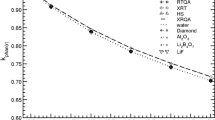Abstract
Three tissue-equivalent cylindrical wound phantoms with varying activities of DU metal imbedded at varying depths were used to compare the efficiencies of a bismuth germinate (BGO) detector, a sodium iodide (NaI), and two identical wound probes with smaller sodium iodide crystals. Our results show that the BGO detector had the highest efficiency (1.0·10-3) and the lowest minimum detectable activity (MDA = 5.8 kBq) for the shallow depth DU phantom, relative to the other detectors. The BGO detector also had the highest peak efficiencies (1.7·10-3 and 5.8·10-4) and the lowest MDAs (3.5 and 10.0 kBq) for the medium and deep phantoms, respectively. Other detectors' performance data are presented.
Similar content being viewed by others
References
B. Altshuler, B. Pasternek, Health Phys., 9 (1963) 293.
Armed Forces Radiobiology Research Institute (AFRRI), Assessment of the Risks from Imbedded Fragments of Depleted Uranium, Technical Report 93–1, Bethesda, 1993.
Armed Forces Radiobiology Research Institute (AFRRI), Protocol for Monitoring Gulf War Veterans with Imbedded Fragments of Depleted Uranium, Technical Report 93–2, Bethesda, 1993.
Army Environmental Policy Institute (AEPI), Health and Environmental Consequences of Depleted Uranium Used by the U.S. Army, Summary Report to Congress, Atlanta, 1994.
Army Environmental Policy Institute (AEPI), Health and Environmental Consequences of Depleted Uranium Used in the U.S. Army, Technical Report, Atlanta, 1995.
Bureau of Radiological Health, U.S. Department of Health, Education and Welfare, Public Health Service, Radiological Health Handbook, Revised ed. January 1970, Rockville, 1970, p. 120.
A. King, L. M. Scott, J. L. Disney, Health Phys., 34 (1977) 112.
G. F. Knoll, Radiation detection and measurement, 2nd ed., John Wiley and Sons, Inc. New York, 1979, pp. 234, 306, 322.
P. C. Olsen, Depleted uranium wound calibration phantom for United States Army TMDE activity, Battelle, Pacific Northwest Laboratory, Washington, Contract #PNL21603: 1994.
H. E. Palmer, G. A. Rieksts, Health Phys., 47 (1984) 569, 577.
H. B. Spitz, R. L. Buschbom, G. A. Rieksts, H. E. Palmer, Health Phys., 49 (1985) 1085.
R. Toohey et al., Health Phys., 60(Sup. 1) (1991) 7.
Author information
Authors and Affiliations
Rights and permissions
About this article
Cite this article
Chandler, S.Z., Ibrahim, S.A. & Campbell, J.G. Comparison of Scintillation Detection Efficiencies of Depleted Uranium (DU) in Wounds. Journal of Radioanalytical and Nuclear Chemistry 243, 451–457 (2000). https://doi.org/10.1023/A:1016034300588
Issue Date:
DOI: https://doi.org/10.1023/A:1016034300588




